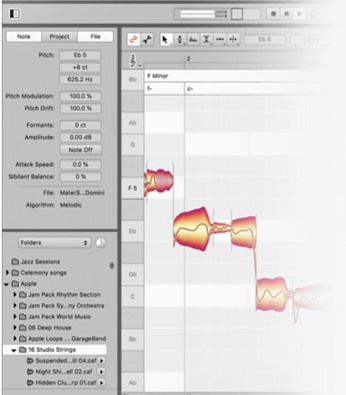|
Melodyne
grants you unrivaled access to all the musical details in your recordings and
samples – note by note. This is made possible by a sophisticated analysis
that delves deeply into your recordings and samples, and recognizes and
understands the musical relationships within them: the individual notes and
their characteristics, the scales, keys and chords, the timing, the tempo,
the tone color. And with Melodyne you can edit all these things intuitively.
With vocals, but every type of instrument as well – including polyphonic
ones, such as the piano and guitar.
In addition
to Melodyne’s basic functions and all the possibilities of the smallest
edition, essential,
Melodyne
assistant offers:
- The entire Melodyne toolkit: With the full
diversity of Melodyne’s tools at your disposal, you can apply the finest
of touches to any and every note parameter: intonation, vibrato, pitch
drift, timing, duration, amplitude, fades, sibilants, formants,
transients – even the timing within notes as well as the transition
between them – and much else besides. You can take a vocal track as
close to perfection as you choose to.
- Inspectors: In the inspectors, all the parameters
are clearly laid out, and you can adjust them – without changing tools –
to the precise values you want.
- Audio-to-MIDI: Export the MIDI equivalent of your
audio, so you can double your vocal lines with a synthesizer or your
acoustic bass with an electronic sound. Audio-to-MIDI gives you the
means to conduct exciting experiments and create radically new sounds.
- In a nutshell: Melodyne assistant provides all you need
for the professional editing of vocals. That’s where its
main power is focused, but it can be used equally well, of course, to
edit recordings of any monophonic sound source (trumpet, clarinet,
etc.).

|
The editions
compared
|
|
|
|
|
|
essential
|
assistant
|
editor
|
studio
|
|
Multi-tracking
– view and manage multiple tracks in a single window
|
|
|
|
X
|
|
Multitrack
Note Editing – edit the notes of multiple tracks simultaneously
|
|
|
|
X
|
|
Track-transcending
macros – apply the macros to multiple tracks simultaneously
|
|
|
|
X
|
|
Quantize to
reference track – make one track adopt the timing of another
|
|
|
|
X
|
|
Sound Editor –
unique, overtone-based sound design
|
|
|
|
X
|
|
DNA Direct
Note Access – algorithms for polyphonic instruments such as piano and
guitar
|
|
|
X
|
X
|
|
Editing of
individual notes within chords – with all the tools and macros
|
|
|
X
|
X
|
|
Extended tempo
functions – map and edit sudden or gradual changes of tempo
|
|
|
X
|
X
|
|
Extended scale
functions – create and modify scales; extract scales from audio material
|
|
|
X
|
X
|
|
Audio-to-MIDI
– export notes to a MIDI file
|
|
X
|
X
|
X
|
|
Inspectors –
swift access to all parameters
|
|
X
|
X
|
X
|
|
All Melodyne’s
tools – for pitch, formants, volume, timing, sibilants
|
|
X
|
X
|
X
|
|
Musically
weighted pitch analysis – for psycho-acoustically optimal intonation
correction
|
X
|
X
|
X
|
X
|
|
Chord Track
and chord recognition – bring notes into line harmonically, extract chords
from audio
|
X
|
X
|
X
|
X
|
|
All the
algorithms without DNA – for melodic, percussive and complex material
|
X
|
X
|
X
|
X
|
|
Edit note
assignments – full control over the algorithms
|
X
|
X
|
X
|
X
|
|
Melodyne’s
Main Tool – edit the pitch, position and duration of notes and note
separations
|
X
|
X
|
X
|
X
|
|
Macros for
pitch, timing, leveling – correct and optimize notes by means of
intelligent automation
|
X
|
X
|
X
|
X
|
|
Stand-alone or
in your DAW – integrated via ARA , AU, VST 3 or AAX
|
X
|
X
|
X
|
X
|
|
Intercompatibility
– open and edit projects created by other editions
|
X
|
X
|
X
|
X
|
|
Compatibility
with Melodyne 4 – open and edit Melodyne 4 projects
|
X
|
X
|
X
|
X
|
System requirements
|
macOS
|
Intel Dual
Core processor (Quad Core or better recommended), 4 GB RAM (8 GB or more
recommended), macOS 10.12 (64-bit) or higher. Melodyne 5.2 or higher runs
native on Apple Silicon Macs.
|
|
Windows
|
Intel or AMD
Dual Core processor (Quad Core or better recommended), 4 GB RAM (8 GB or
more recommended), Windows 10 (64-bit), Windows 11, ASIO-compatible audio
hardware.
|
|
Activation
|
Computer-based
or iLok USB dongle (2nd or 3rd generation), Melodyne essential only
computer-based. Internet access is required for the first activation.
|
|
Interfaces
|
Plug-in
operation via VST3, AU or AAX. ARA integration with compatible DAWs, as set
out in the section on DAW compatibility.
|
The system
requirements listed above apply when Melodyne is running as a stand-alone
program. When it is running as a plug-in, however, the system requirements of
the DAW must also be met. You will find further information regarding DAW
compatibility in the following frame.
|